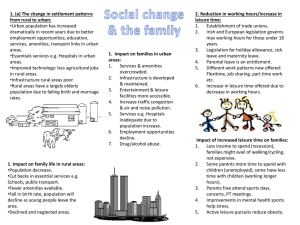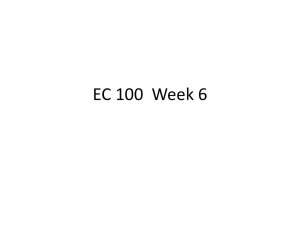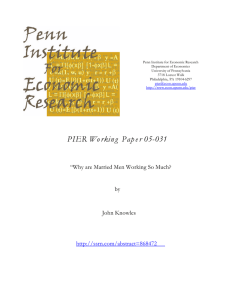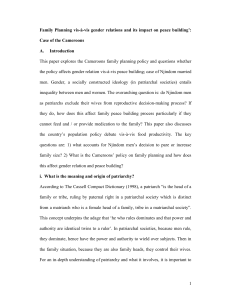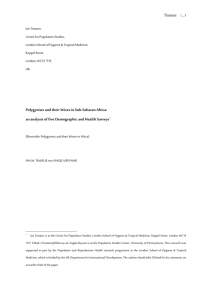Chapter 12
advertisement
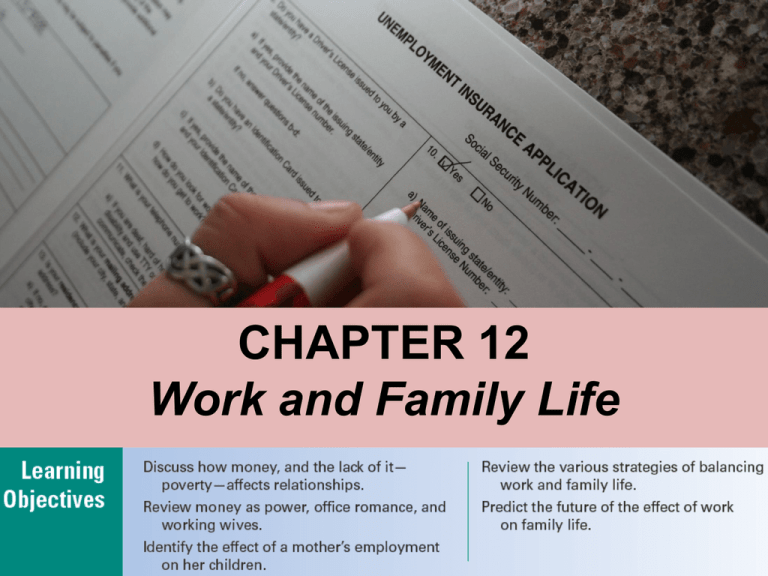
CHAPTER 12 Work and Family Life Chapter 12: Work and Family Life Chapter Outline • • • • • • Money and Relationships Work and Marriage: Effects on Spouses Work and Family: Effects on Children Balancing Work and Family Life Balancing Work and Leisure Time The Future of Work and Family Life Chapter 12: Work and Family Life Introduction • One survey noticed a link between homicides in the family and economic deprivation. • Impoverished families, including those riddled with unemployment, were contexts for homicide. • Discussion: – How do economic forces affect the family structure? Money and Relationships • Effects of the Recession – Tax increases – Government services decreases – Retirement age increases – Incomes decrease – Uncertainty – Big institutions no longer take care of their workers Money and Relationships • Effects of Poverty on Marriages and Families – – – – – Poorer physical and mental health Lower personal and marital satisfaction Lower life expectancy Relationship conflict Stress leading to substance abuse, domestic violence, child abuse and neglect, divorce, and questionable parenting practices – Teenage pregnancy Money and Relationships • Financial Behaviors of Undergraduates and Young Adults – 51.7% of undergrads reported not using a budget – 52.2% of undergrads save money – Undergrads and young adults who budget and save reported more discussion of finances with parents and friends and observed more parents’ and friends’ financial behaviors – Characteristics of undergrads who budget and save: white, pair-bonded, and older Work and Marriage: Effects on Spouses • About 60% of wives work today, nearly double the percentage in 1960. • Generally speaking, the more money a partner makes, the more power that person has in the relationship. • Although two-thirds of all husbands in dualincome families make more money than their wives, women are more likely to make the decisions in more areas. • Higher education increases a woman’s power in the relationship. Working Wives • 70% of all U.S. wives with children are in the labor force. • Mothers are most likely to enter the work force when their children are teenagers. • Only 13% of families are “traditional” in the sense of a breadwinning husband and a stay-at-home wife. • Mommy track: stopping paid employment to spend time with young children. Wives Who “Opt Out” • Opting Out: women leaving their careers and returning home to take care of their children • Reasons for opting out: – Husband is unavailable or unable to “shoulder significant portions of caregiving and family responsibilities.” – Employers encourage and support women parental leave but do not help “much in the way of making it possible for them to return or stay once they had babies.” Office Romance • In one survey, 60% of respondents said they had been involved in an office romance • Another survey found 40% of respondents had an office romance • About 32% of the office romances ended in marriage Dual-Career Marriages • • • • HIS/her career HER/his career HIS/HER career marriage THEIR career marriage Effects of the Wife’s Employment • • • • Role overload Second shift Role strain Benefits to husbands – Relieved of the sole responsibility for the family’s financial support – Freedom to quit jobs, change jobs, or go to school – Potential to form a closer bond with their children Effects of Wife’s Employment on the Marriage • Woman’s employment does not affect a happy marriage but can affect an unhappy one • Highest marital satisfaction and equitable division of housework • Having control over the hours one works is related to positive family functioning Work and Family: Effects on Children • Quality time • Day care considerations – More than half of U.S. children are in centerbased child-care programs – Quality of day care Effects of the Wife’s Employment on the Children • Children do not appear to suffer cognitively or emotionally as long as positive, consistent child care alternatives are in place • Self-Care/Latchkey Children Balancing Work and Family Life • Superperson Strategy • Cognitive Restructuring • Delegation of Responsibility and Limiting Commitments • Time Management • Role Compartmentalization Balancing Work and Leisure Time “Technology is such that a person may never detach from work and stay connected to the office even on vacation.” • How does the above statement reflect the changing nature of leisure in America? Leisure • Use of time to engage in freely chosen activities perceived as enjoyable and satisfying • Changing nature of leisure and work for millennials (those born between 1980 and 1995) Leisure • Benefits of Leisure Time – Relieve work-related stress and pressure – Facilitate social interaction and family togetherness – Foster self-expression, personal growth, and skill development – Enhance overall social, physical, and emotional well-being Leisure • Problems with Leisure Time – Excessive drinking – Relationship problems related to television watching, travel, time, and video games – Vacation stress What If? Quick Quiz 1. What is role overload? a. not having time or energy to meet the demands of role responsibility b. being on the second shift c. getting too much into one's role as parent d. taking on both gender roles of parent Quick Quiz 2. What is most likely the primary concern of an employed parent? a. b. c. d. pleasing their employer juggling demands of work and family making enough money finding time for the spouse Quick Quiz 3. The housework and child care that employed women do when they return home from their jobs is called: a. b. c. d. the fourth shift the third shift the second shift the first shift Quick Quiz 4. Which of the following can be a disadvantage of leisure time? a. b. c. d. Relieve work-related stress. Foster self-expression. Enhance social well-being. Excessive drinking. Quick Quiz 5. When the careers of both the wife and husband are given equal status in the relationship, the couple has a commuter marriage, which is also called: a. b. c. d. HIS/HER career HIS/her career HER/his career THEIR career

